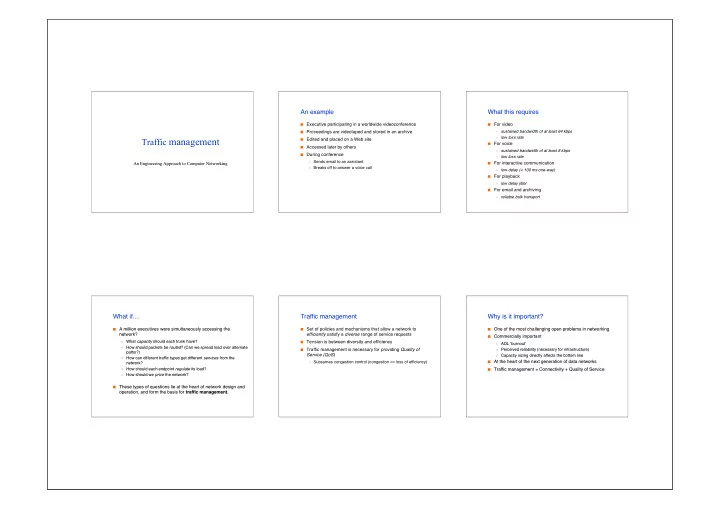

An example What this requires Executive participating in a worldwide videoconference For video Proceedings are videotaped and stored in an archive sustained bandwidth of at least 64 kbps low loss rate Traffic management Edited and placed on a Web site For voice Accessed later by others sustained bandwidth of at least 8 kbps During conference low loss rate Sends email to an assistant An Engineering Approach to Computer Networking An Engineering Approach to Computer Networking For interactive communication Breaks off to answer a voice call low delay (< 100 ms one-way) For playback low delay jitter For email and archiving reliable bulk transport What if… Traffic management Why is it important? A million executives were simultaneously accessing the A million executives were simultaneously accessing the Set of policies and mechanisms that allow a network to One of the most challenging open problems in networking One of the most challenging open problems in networking network? network? efficiently satisfy a diverse range of service requests Commercially important Commercially important What What capacity capacity should each trunk have? should each trunk have? Tension is between diversity and efficiency AOL AOL ʻ burnout burnout ʼ How should packets be How should packets be routed routed ? (Can we spread load over alternate ? (Can we spread load over alternate Traffic management is necessary for providing Quality of Perceived reliability (necessary for infrastructure) Perceived reliability (necessary for infrastructure) paths?) paths?) Service (QoS) Capacity sizing directly affects the bottom line Capacity sizing directly affects the bottom line How can different traffic types get different How can different traffic types get different services services from the from the At the heart of the next generation of data networks At the heart of the next generation of data networks Subsumes congestion control (congestion == loss of efficiency) network? network? How should each endpoint How should each endpoint regulate regulate its load? its load? Traffic management = Connectivity + Quality of Service Traffic management = Connectivity + Quality of Service How should we How should we price price the network? the network? These types of questions lie at the heart of network design and These types of questions lie at the heart of network design and operation, and form the basis for traffic management. operation, and form the basis for traffic management.
Outline Basics: utility function Example Economic principles Economic principles Users are assumed to have a utility function that maps from a Let u = S - a t given quality of service to a level of satisfaction, or utility Traffic classes Traffic classes u = utility from file transfer Utility functions are private information Utility functions are private information S = satisfaction when transfer infinitely fast Time scales Time scales Cannot compare utility functions between users Cannot compare utility functions between users t = transfer time Mechanisms Mechanisms Rational users take actions that maximize their utility a = rate at which satisfaction decreases with time Some open problems Some open problems As transfer time increases, utility decreases Can determine utility function by observing preferences If t > S/a, user is worse off! (reflects time wasted) Assumes linear decrease in utility S and a can be experimentally determined Social welfare Example Some economic principles Suppose network manager knew the utility function of every Assume A single network that provides heterogeneous QoS is better A single network that provides heterogeneous QoS is better user than separate networks for each QoS than separate networks for each QoS Single switch, each user imposes load Single switch, each user imposes load 0.4 0.4 Social Welfare is maximized when some combination of the A ʼ s utility: s utility: 4 - d 4 - d unused capacity is available to others unused capacity is available to others utility functions (such as sum) is maximized B ʼ s utility : s utility : 8 - 2d 8 - 2d Lowering delay of delay-sensitive traffic increased welfare Lowering delay of delay-sensitive traffic increased welfare Same delay to both users Same delay to both users An economy (network) is An economy (network) is efficient efficient when increasing the utility of when increasing the utility of can increase welfare by matching service menu to user can increase welfare by matching service menu to user one user must necessarily decrease the utility of another one user must necessarily decrease the utility of another Conservation law Conservation law requirements requirements BUT need to know what users want (signaling) BUT need to know what users want (signaling) An economy (network) is An economy (network) is envy-free envy-free if no user would trade places if no user would trade places 0.4d + 0.4d = C 0.4d + 0.4d = C => => d = 1.25 C d = 1.25 C => => sum of utilities sum of utilities = 12-3.75 C = 12-3.75 C For typical utility functions, welfare increases more than linearly For typical utility functions, welfare increases more than linearly with another (better performance also costs more) with another (better performance also costs more) If B If B ʼ s delay reduced to s delay reduced to 0.5C 0.5C, then A , then A ʼ s delay = s delay = 2C 2C with increase in capacity with increase in capacity Sum Sum of utilities of utilities = 12 - 3C = 12 - 3C Goal: maximize social welfare individual users see smaller overall fluctuations individual users see smaller overall fluctuations Increase in social welfare need not benefit everyone Increase in social welfare need not benefit everyone subject to efficiency, envy-freeness, and making a profit can increase welfare by increasing capacity can increase welfare by increasing capacity A loses utility, but may pay less for service A loses utility, but may pay less for service
Recommend
More recommend